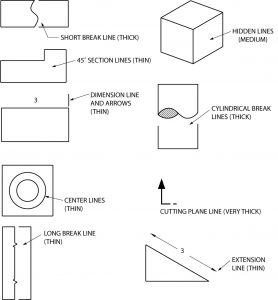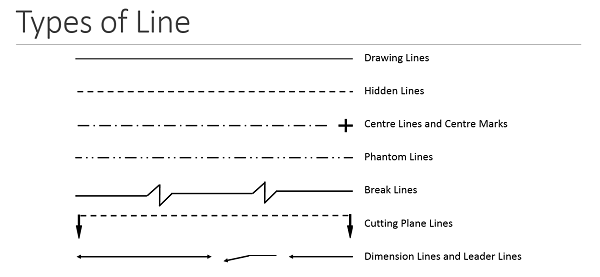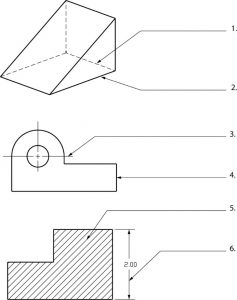Basic Types of Lines Used in Engineering Drawings By Kelly Curran Glenn Sokolowski. For most engineering drawings you will require two thickness a thick and thin line.

The Language Of Lines Basic Blueprint Reading
Therefore any surface that is not in line with the three major axis needs its own projection plane to show the features correctly.

. The standard views used in a three-view drawing are the top front and the right side views. The arrows represent the direction of the line of sight for the section view and they point away from the sectioned view. A leader is a thin line used to connect a dimension with a particular area figure 24.
This line is used to represent the location of a cutting plane. Hidden Lines Thin type lines consist of thin short dashes closely and evenly spaced. Visible outline or object line.
Dimension Line Thin lines capped with arrowheads which may be broken along their length to provide space for the dimension numerals. The object lies In between the observer and the plane of projection. A quiz completes the activity.
Engineering Working Drawings Basics Page 8 of 22 parallel to the object surface. Detail Views A detail view is a separate large-scale drawing view of a small section of another view. An extension line extends a line on the object to the dimension line.
In addition to the views of the object an engineering drawing includes technical information about a design including necessary materials product specifications and dimensions. It is a thin continuous line and is used for the purpose of sectioning an object. Three orthographic views in firstangle projection are given in Fig.
The lines we created were all of the same thickness and type. There are different types of lines used in engineering drawing. In this highly interactive object learners associate basic line types and terms with engineering drawing geometry.
07 mm dashed lines that extend past the edge of the object6 mmand have line segments at each end drawn at90 degrees and terminated with arrows. Although THICK lines of Type-E are recommended for representing the hidden edges THIN lines of Type-F are preferred. The object is assumed to be placed in first quadrant.
Types of Lines The basis of any drawing is a line. A line representing changes of pressure or temperature under conditions of constant volume. Isometric projection is a method for visually representing three-dimensional objects in two dimensions in technical and engineering drawings.
Cutting plane lines are thick lines that run through the center of the object that the interior wants to provide an interior view of. This line is used to show hidden edges of the main object. In oblique projection the object is aligned such that one face front face is parallel to the projection plane.
The front view or the elevation Is always above the top view or the plan. The first dimension line should be approximately 12 mm 06 in from the object. This line is located in front of cutting planes outlines of adjacent parts censorial Lines and to state center of gravity.
Swing the pencil back and forth between the points barely touching the paper until the direction is clearly established. What is line in basic technology. The data within a technical drawing may also include administrative notes about the company project completion dates and project revisions.
CONSTRUCTION LINE Very light and thin line use to construct layout work. These lines are drawn to represent hidden or invisible edges of the objects. It is assumed that an object is placed in front of a screen and light projected on the object assuming that the rays of light to be parallel to each other and perpendicular to the screen then a true shadow of.
Two perpendicular lines with arrows showing in which direction the interior of the object should be viewed are drawn at the end of the line. A visible line or object line is a thick continuous line used to outline the visible edges or contours of. Section line or hatching line.
The right hand end viewside view Is drawn to the left and left hand end view Is drawn to. The outline or object line is represented by thick line and is used to show the outer visible feature of the object in the drawing. These thick solid lines show the visible edges corners and surfaces of a part.
Centre lines Lines of Symmetry Trajectories and Pitch Circles. How many types of projection angles are there. Table 1 shows the types and thickness of lines used for various purposes.
Object lines Dark pencil lines used to mark the boundaries of an object in an engineering drawing Dimensions The distances and locations on an actual object. Object lines stand out on the drawing and clearly define the outline and features of the object. OBJECT OR VISIBLE LINES Thick dark line use to show outline of object visible edges and surfaces.
Two types of lines are acceptable for cutting plane lines in multi-view drawings. The plan on which the projection of the object is taken is called the projection plan. Spot the beginning and end points.
Object lines Figure 3 are the most common lines used in drawings. The corners of the block are used to position a line DF in space. DIMENSION LINE Thin and dark lines use to show the size span of an object with a numeric value.
Types of lines and their uses in basic technology. Definition of isometric line. 2 The Language of Lines Object Line.
The use of a right type of line results in a correct drawing. Extension lines begin 15 mm from the object and extend 3 mm from the last dimension line. An isometric view of a rectangular block is shown in Fig.
Usually terminates with arrowheads or tick markings. This line is used to represent the center line for circles and arcs. A hidden line also known as a hidden object line is a medium weight line made of short dashes about.
A line such as a contour line drawn on a map and indicating a true constant value throughout its extent. Draw the line firmly with a free and easy wrist-and-arm motion. In such projection the projectors are not perpendicular to the plane of projection rather inclined to the plane of projection at 30 45.
The Bureau of Indian Standards has prescribed the types of lines in its code IS-10714-1983 to be used for making a general engineering drawing. The plane of projection Is always behind the object. It is an axonometric projection in which the three coordinate axes appear equally foreshortened and the angle between any two of them is 120 degrees.
112 and it will be apparent that the projected length of the line DF in each of the views will be equal in length to the diagonals across each of the rectangular faces. But lines on an engineering drawing signify more than just the geometry of the object and it is important that you use the appropriate line types. The imaginary lines drawn from the object to the plane are called projectors or projection lines.
Similarly what is cutting plane line in engineering drawing. Drawing is the standard used in engineering and technology because many times the other three principal views are mirror images and do not add to the knowledge about the object. Hold the pencil naturally.

The Language Of Lines Basic Blueprint Reading

Engineering Drawing Notes B Engineering Drawings Elements And Principles
Why Do We Use Hidden Lines In Engineering Drawing Quora

What Are Lines Types Of Lines In Engineering Drawing Youtube

Engineering Design And Cad A B Line Types Flashcards Practice Test Quizlet

0 comments
Post a Comment